Euro 2016: How is French security ensuring fan safety?
- Published
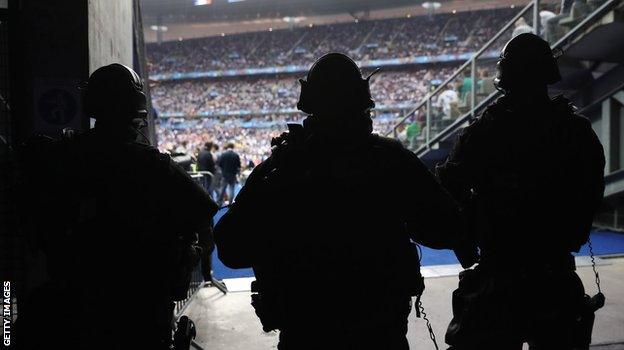
Security was high at the opening game of Euro 2016 at the Stade de France between France and Romania
Matchday four at Euro 2016 between the Republic of Ireland and Sweden - and two sets of supporters known for their colour and warmth - was expected to pass off safely enough.
There was no publicised intelligence about any threat to the safety of football fans visiting the venue for the Group E fixture at Stade de France.
Yet security services in Paris were still on the highest possible alert - a state of readiness that has remained in place since November's attacks in the city - wary and ready to respond.
The attacks claimed 130 lives but the total could have been much higher had three bombers not been stopped in their attempts to get inside the stadium as it hosted a France v Germany international friendly match.
What happened that night - and what could have happened - is why 90,000 security staff (42,000 national police officers, 30,000 local gendarmes and 10,000 soldiers in combat gear among them) have been deployed for the tournament.
The venue - Stade de France
Getting into football matches at a tournament like Euro 2016 is not a quick process.
Four hours before the game, pockets of fans of both teams were setting off from Gare du Nord.
The stadium, 10km north of the centre of Paris in Saint-Denis, was built to host the 1998 World Cup final and is one stop from Gare du Nord station.
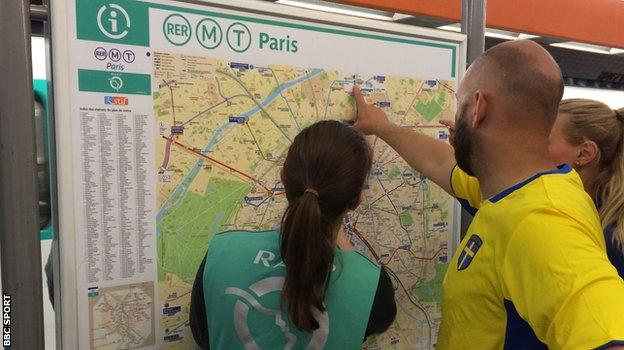
The Stade de France is enough to get to, especially as the local transport operator, Regie Autonome des Transports Parisiens (RATP), has helpers at each stop to assist those less familiar with the many lines that criss-cross the French capital.
Both sets of fans were already mixing merrily side by side as the Reseau Express Regional (RER) 'fast' train pulled out of the station.
Jan Bjerlestam, from the south of Sweden, said: "We have been in Paris for a few days and it does not feel insecure. We were not nervous about coming, we talked about it but it is just our mums who are worried.
"The tram here was packed with both Swedish and Irish fans; the atmosphere was great, with everyone singing Abba songs."
Ten minutes later and the RER arrived at La Plaine Stade de France, a 15-minute walk from the venue.

As both sets of fans stepped onto the platform, they were greeted by a modest security presence, plus one weary-looking police dog.
A swift walk down to street level and it was party time: a mass of the green of the Republic of Ireland and the yellow of Sweden.
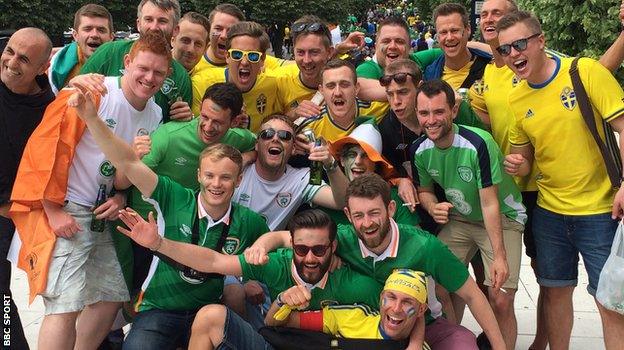
Shirts, flags, scarves, costumes and wigs were prevalent and not a hint of anything sinister in the air. The atmosphere was good as fans from both teams got themselves into groups for photographs
What many fans may not have noticed was the volume of police around them. Dozens of officers from the National Police were lurking. Some mixed with supporters in the middle of the pavements, but many more posted on the corners of the many side streets surrounding the stadium.
Police vans were parked bumper to bumper along some of those roads - all full of officers ready and waiting to deal with any problems, should they arise.
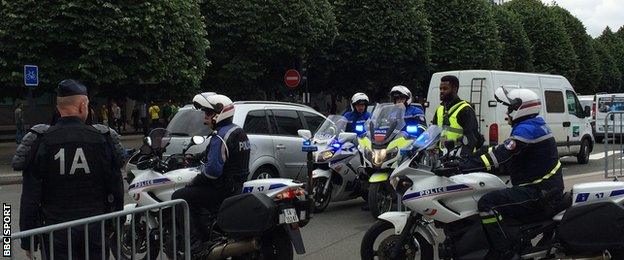
"I expected there to be more security," said William O'Riordan, from Cork. "I expected more police, but there haven't been too many. It seems pretty low key."
Police marksmen were positioned at strategic points around the stadium but they did not want their photograph taken.
What was also notable was a lack of ticket touts in the area. I only saw one, skulking along the side of a pavement, keeping well out of the sight of the authorities.

Several police officers on horseback added to the presence of the security force about 500 metres from the venue
Perimeter security
Did you know there are 42km of temporary fences - 26km of high fences and 16km of low barriers - at the Euro 2016 venues?
They act as security cordons, enabling the authorities to carry out checks on supporters as they get nearer to the ground.
At Stade de France, the barriers become more pronounced the closer you walk to the stadium, manned by some of the 1,200 stewards on duty for this game.
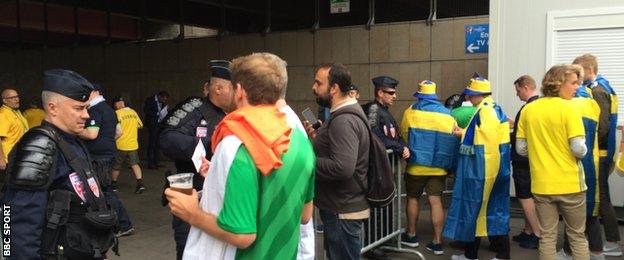
The role of the outer layer was to ensure supporters had tickets and that prohibited items were not being smuggled inside.
What are the prohibited items? Weapons, of course, plus anything that could be used as a weapon, as well as bottles, jugs or cans, objects made from glass, fireworks, flares, smoke bombs, gas spray cans, laser pointers, flying objects, large flags, banners and animals.
The first body and bag searches took place here, with fans filing through one at a time. Still, they were good natured as they came within 200 metres of the stadium.
"There were a lot of police closer to the stadium, but I felt safer seeing police with guns," said Sweden fan Hampus Larsson, from Halmstad. "There was no trouble and we have a great relationship with the Republic of Ireland fans."
Security checks going into stadium
Closer to the stadium came security check number two. This time it wasn't stewards doing the checking, it was armed police officers. Tickets and possessions were checked, again, but fans were allowed to take beer through, as long as it was in plastic cups.
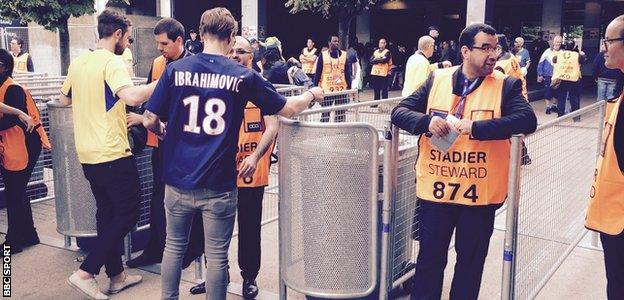
Once inside the inner security zone, fans went through electronic barriers, which only opened with the correct ticket barcode.
"I feel safer in the ground than around the streets of Paris, at least here in the ground nothing can be brought in," said Republic of Ireland fan John Fitzpatrick, from Athlone.
With regular bomb sweeps at all venues and fan zones throughout France, no chances were being taken and there was yet another search and body check before entry to the stadium concourses was permitted.
Stade de France stewards checked everybody again and confiscated any remaining banned items.
Republic of Ireland fan Dave Devane from Killarney, County Kerry said: "Their job is easy because the Irish are not here to cause trouble. We have spoken to some of the police who told us they think the Irish are a pleasure to deal with."

"The police are like 'Terminators' and know what they are looking for," says Republic of Ireland fan Dave Devane (orange hat, second from right)
Inside the ground
The bulk of the 1,200 stewards were posted inside the stadium and, while there were pockets of mixed yellow and green shirts, most of the crowd was segregated.
Segregation is not a perfect science, but Uefa did a pretty decent job here. It was easy to see the swathes of yellow and green shirts were largely at opposite ends of the stadium, with the people in green slightly outnumbering their Swedish counterparts.
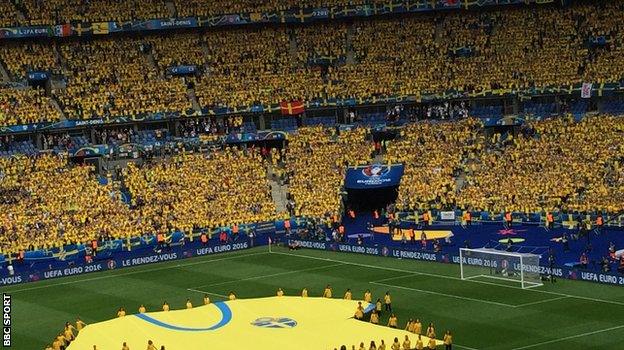
The crowd behaviour was pretty much impeccable. There was no antagonism, racist chanting, objects thrown, fire crackers let off.
Police later told me there had been no trouble, adding the fans were "super, the Irish were brilliant".
However, one flare was set off in the Sweden end when the team scored.
The official attendance was 73,419, which left about 3,500 empty seats in the stadium.
Leaving the stadium
Bernard Cazeneuve, the French interior minister, initiated various fresh security measures at stadiums in the wake of the trouble which broke out at the end of Saturday's game between England and Russia in Marseille, when Russian fans charged the England supporters at one end of the ground.
Football Association chairman Greg Dyke has criticised the security arrangements that allowed that to happen.
But Cazeneuve's initiatives - including a guarantee to make end-of-match exit points safe for fans - appeared to be in place and there were no incidents at the end of the 1-1 draw.
There were police sirens going off in streets around the stadium afterwards but that is not uncommon in Paris. And, while the traffic congestion in the vicinity was pretty bad, there were no reports of trouble.
While this observation was a one-off situation and no comparison can be drawn with the opening match of Euro 2016 between France and Romania, it seems - on the face of it - that security at Stade de France is in order.
That was certainly the feeling among many fans, such as Ireland supporter Devane.
"I feel safer here than when we go to matches back home," he said.
- Published13 June 2016

- Attribution
- Published14 June 2016
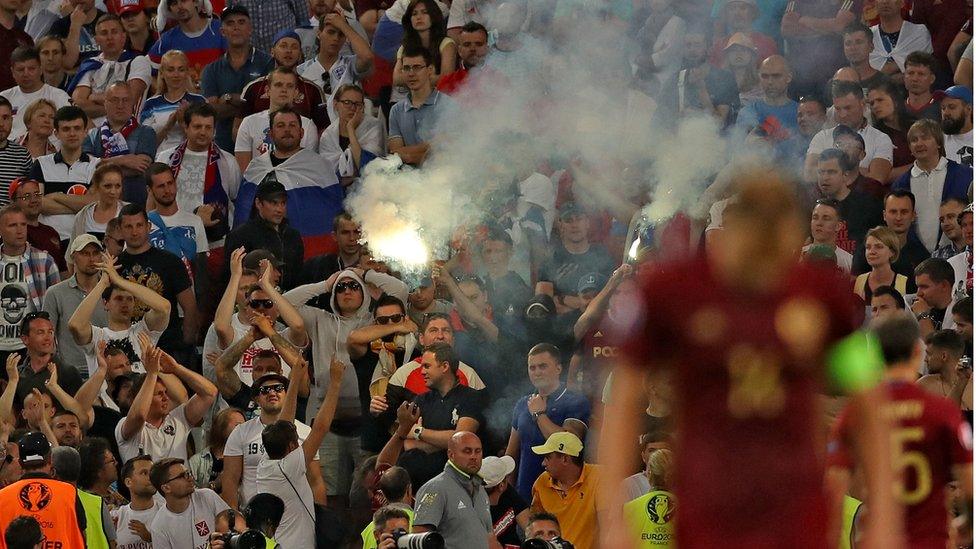
- Published13 June 2016
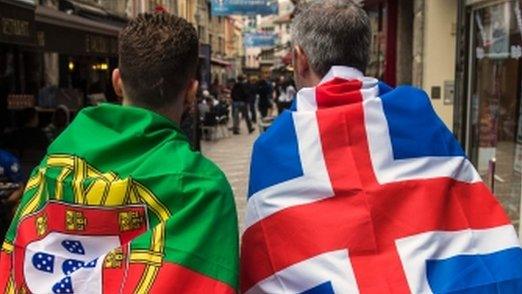
- Published14 June 2016
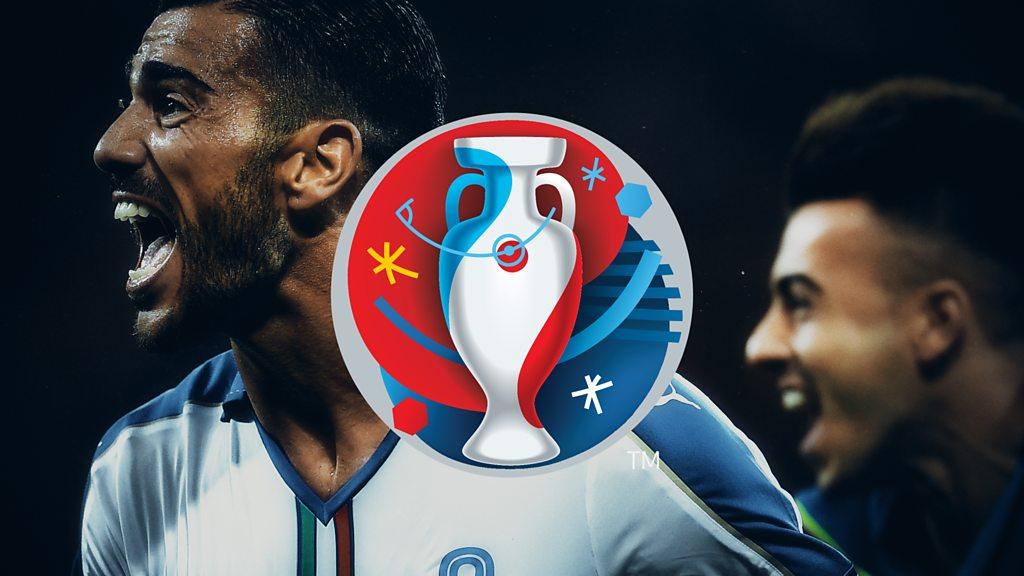
- Published13 June 2016
